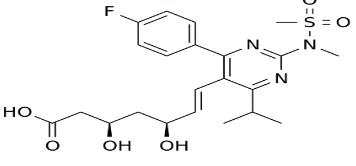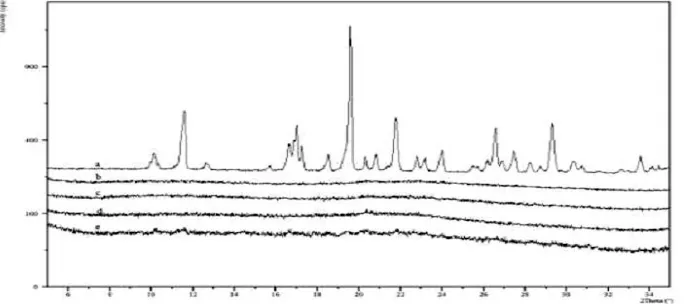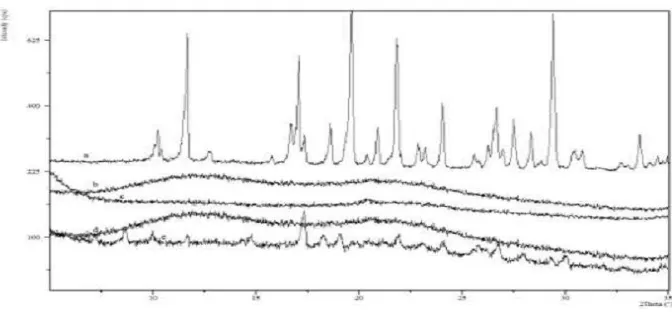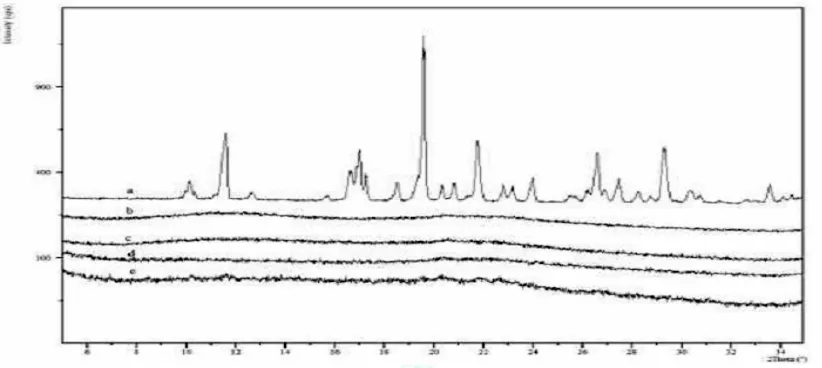Available online on 22.06.2019 at http://jddtonline.info
Journal of Drug Delivery and Therapeutics
Open Access to Pharmaceutical and Medical Research© 2011-18, publisher and licensee JDDT, This is an Open Access article which permits unrestricted non-commercial use, provided the original work is properly cited
Open Access
Research Article
Preformulation Studies of Rosuvastatin
Pallavi Rajput*
, Anju Gauniya
Department of Pharmaceutical Technology, NIET, Greater Noida.
ABSTRACT
Reliable experimental determination of the solubility of active pharmaceutical ingredients (APIs) in solvents and the correlation for solubility analysis is crucial for the accelerated design and optimization of procedures in the drug industry for isolation, purification and formulation. In this study, the antihypercholesterolemic drug rosuvastatin was evaluated for solubility, effect of pH, compatibity with various exepients. In this research, the rosuvastatin, an antihypercholesterolemic drug was analysed for solubility, pH effect, and compatibility with different excipients. Drug dispersion subjected to Differential scanning calorimetry and X-ray powder diffractometry.
Keywords: Hypercholesterolaemia, HMG-CoA reductase inhibitors, DSC, XRPD
Article Info:Received 02 April 2019; Review Completed 06 June 2019; Accepted 10 June 2019; Available online 22 June 2019
Cite this article as:
Rajput P, Gauniya A, Preformulation Studies of Rosuvastatin , Journal of Drug Delivery and Therapeutics. 2019;
9(3-s):729-735 http://dx.doi.org/10.22270/jddt.v9i3-s.2968
*Address for Correspondence:
Pallavi Rajput, Department of Pharmaceutical Technology, NIET, Greater Noida.
INTRODUCTION
Cholesterol is a fat-like, smooth, waxy substance that is a naturally occurring substance of all body's cells. Our body produces all cholesterol that is required.High cholesterol increases the possibility of coronary heart disease (CHD) like heart attack, and stroke. Significant amounts cholesterol present in the blood can induce sticky clusters on the arterial walls (aptly named plaque). Plaque may restrict or interrupt blood circulation to the brain, heart, as well as
other organs inevitably.1 Blood cells become captured to
produce clots on the plaque. Clots can sometimes spontaneously break loose and interrupt blood supply within an artery altogether, triggering a stroke or heart attack.2
Hypercholesterolaemia has a central role in atherosclerosis and cardiovascular disease evolution. The likelihood of atherosclerosis process transition to coronary heart disease is rising rapidly as total serum cholesterol or low-density lipoprotein (LDL) cholesterol goes up at individual and
population levels.3
The inhibitors of HMG-CoA reductase are reversible inhibitors of the HMG-CoA reductase microsomal enzyme which transforms HMG-CoA to mevalonate. HMG-CoA is an essential but rate limiting step in the biosynthesis of cholesterol. Inhibition of HMG-CoA reductase by HMG-CoA
reductase inhibitors cuts intracellular cholesterol
biosynthesis, causes a transcriptionally upregulated release
of microsomal HMG-CoA reductase on the cell surface LDL receptor.4
Pravastatin, simvastatin, lovastatin, fluvastatin, atorvastatin, and cerivastatin are the HMG-CoA reductase inhibitors principally used in clinical applications. Simvastatin,
lovastatin and pravastatin is extracted from fungi .5
Rosuvastatin also belongs to the HMG CoA reductase inhibitors ("statins"). The activity of rosuvastatin in inhibiting HMG-COA reductase has been studied in the purified human catalytic domain showed that rosuvastatin was more potent than other available statins with the least
50% inhibitory concentration [IC50] of 5.4Nm.6,7
Previous research have demonstrated that rosuvastatin has highest amount of binding interactions with active site of the enzyme .Rosuvastatin and atorvastatin have additional interaction with the enzyme not seen with the other synthetic statins. These differences in the number and types of bonds between the statin and enzyme may explain the relatively greater efficacy of atorvastatin and rosuvastatin to
lower LDL- cholesterol. Through in-vitro and in-vivo studies,
the premise that greater binding to the enzyme results into
higher statin potency appears to be proved.8
Rosuvastatin ((3R,5S,6E)-7- [4-(4-fluorophenyl)-6-
(1-methylrthyl)-2- [methyl (methylsulfonyl)
suspension of the drug gives a pH of 6. It has been reported that it is a blend of crystalline and amorphous forms, which
ultimately determines its solubility and bioavailability in
in-vivo studies. It shows maximum stability at pH 5 in buffered
pH solution and pH 6 & 7 in un-buffered pH solutions. Because of its greater solubility, stability at higher pH (pH 6-9) values and amphoteric nature, it is well absorbed
throughout the gastrointestinal tract and more
predominantly from small intestine.9
Figure 1.: Structure of Rosuvastatin.
Solubility and permeability (including metabolic
transformation) of drugs are essential parameters determining bioavailability. Rosuvastatin calcium is a BCS class II drug. Permeability of BCS class II drugs over the intestinal membrane is fast, and hence the absorption will mainly be determined by the dissolution rate of the drug in
the GI fluids. 10Therefore, ways to enhance the dissolution
rate of poorly water-soluble drugs becomes a challenge. 11
Different methods are employed to improve the dissolution characteristics of poorly water-soluble drugs like solubilization, pH adjustment, cosolvents, microemulsion,
self emulsification, polymeric modification, drug
complexation, and particle size reduction, use of a surfactant as a solubilising agent, the pro-drug approach and dry
dispersions. 12 This study aimed to prepare ternary solid
dispersions granules for a poorly Water-soluble drug Rosuvastatin to improve its solubility.
MATERIALS AND METHODS
Chemical reagentsAll the chemicals used in this study were obtained from Hi-Media Laboratories Pvt. Ltd. (Mumbai, India), Sigma-Aldrich Chemical Co. (Milwaukee, WI, USA), and SD Fine-Chem. Ltd. (Mumbai, India). All the chemicals used in this study were of analytical grade.
Preformulation Study
Preformulation testing is an investigation of physical and chemical properties of a drug substance alone and when combined with excipients. It is the first step in the rational
development of dosage forms.13
Solubility studies
The solubility of Rosuvastatin was studied in various aqueous and non-aqueous solvents. 10 mg of drug was taken in 10 ml of each solvent at room temperature in screw-capped test tubes and shaken for 30 minutes in a sonicator. The solubility of Rosuvastatin at Range of pH:
Equilibrium solubility measured at a range of pH values shows pH dependence. The compound Rosuvastatin is relatively soluble at pH values above 4 and highly soluble at pH 6.6 citrate buffers.
Powder Flow Properties: -
When limited amounts of drugs are available, powder flow properties can be evaluated by measurements of bulk
density and angle of repose. Changes in particles size and shape are significant as an increase in crystal size, or a more uniform shape will lead to a small angle of repose and a smaller Carr’s index.
Compatibility Studies
One of the requirements for the selection of suitable excipients or carrier for the pharmaceutical formulation is its compatibility. Rosuvastatin was mixed with the various excipients in the different ratio(s). Further, it was stored in sealed glass vials and subjected to varying conditions of temperature and humidity (25°C/60%RH, 30°C/65%RH, 40°C/75%RH.)
After the completion of the specified period, blends were evaluated for their physical change, moisture content, and impurity profile.
Preparation of Solid Dispersions
The basic model used in the present study consists of multicomponent blends of drug substances with excipients, and stored in closed vials for specific periods of time. Samples were analyzed for stability (appearance, color, etc.) after specified period of storage. This formulation was made using the Solvent Evaporation method The three different ratios of Rosuvastatin (drug) to KollidoneVA64 (carrier) were 1:9; 3:7; and 7:3. Rosuvastatin and KollidoneVA64 were added to a beaker containing the required amount of ethanol (solvent). Once these two components were dissolved in the solvent, NeusilinUS2 (adsorbent) was added and thoroughly mixed. The slurry formed with the solution of Rosuvastatin and KollidonVA64 in ethanol, and NeusilinUS2 was dried. The product was then stored in an airtight container in a dark, cool place until further analysis. Differential Scanning Calorimetry (DSC)
The DSC curves of each mixture were obtained using a Mettler Toledo DSC 25 measuring cell equipped with a heat flow sensor and joined via interface TA Controller TC 15 to a computer. The measurements were driven by STARe software. Samples for DSC measurements were sealed in 40-μl standard aluminium crucibles with a single hole punched in the lid. An empty pan of the same type was employed as a reference. The DSC instrument was calibrated with the melting point of indium (156.6 °C) as a standard. DSC scans of each mixture were performed at a heating rate of 5 °C min−1 in the temperature range of 30–170 °C. The DSC cell was purged with a stream of dry argon at a rate of 50 cm3 min−1. Experiments were performed in triplicate, and the
mean values were calculated.14
X-Ray Powder Diffractometry
Powder diffraction patterns of all samples were completed over the range 2θ from 5° to 40°, at steps of 0.0084° and a counting time of 1.00 ° min−1 using PAN analytical X-Pert Pro V1.6 with X-Pert Data Collector V2.1 software was used equipped with a CuKα2 anode tube and diffract meter of radius 240 mm.
RESULTS AND DISCUSSION
Result of Preformulation Study:Rosuvastatin is an off white to white crystalline powder,
with a melting point of 122○C.Solubility profile of
rosuvastatin is tabulated in Table 1 and 2. Rosuvastatin is
relatively soluble at pH values above 4 and highly soluble at pH 6.6 citrate buffers. The physical characterization of the dry dispersion is tabulated in Table 4
Table 1 Solubility profile of Rosuvastatin with various solvents
Solvent* Value Inference
Water 8.86e-02 g/l Very Slightly Soluble
Dimethyl Formamide 10.0 mg/ml Sparingly Soluble
Ethanol 0.86 mg/1000ml Very Slightly Soluble
Methanol 0.95mg/ml Slightly Soluble
0.1M HCl 28 mg/ml Soluble
0.1 M NaOH 1 mg/ml Slightly Soluble
DMSO 14 mg/ml Sparingly Soluble
* Solubility (at 25 °C)
Table 2Solubility profile of rosuvastatin at range of pH
Buffer Solubility* Final pH
pH 1.2 HCL Acid (0.1N) 0.5±0.0 1.2
pH 1.2 HCL Buffer ■ 0.5±0.0 1.2
pH3.6 Acid phthalate Buffer■ 1.6±0.1 4.1
pH 4.0 Acid phthalate Buffer ■ 2.2±0.2 4.5
pH 4.6 Neutralized phthalate Buffer■ 3.7±0.2 5.0
pH5.6 Neutralized phthalate Buffer■ 9.2± 0.5 5.3
pH6.0 Phosphate Buffer■ 10.7± 0.3 5.6
pH 6.6 Citrate Buffer■ (0.005M) 48.8± 0.6 6.7
pH7.0 Phosphate Buffer ■ 17.1± 0.0 6.8
ph7.4 Phosphate Buffer ■ 21.0± 0.7 7.1
Deionised water 7.8± 0.1 7.0
* Solubility (at 25 °C) ■ USP
Compatibility Study
Some factors that may have pertinent effect on the stability of drug in the presence of additives are the chemical nature of the excipient, drug to excipient proportion, humidity, microenvironmental pH of the medication-excipient blend,
temperature, and light. The model allowed identification of the potential roles of all of these factors on dosage form
stability 14 Drug and excipient compatibility data for
appearance and moisture content were observed and recorded in Table3
Table 2: Rosuvastatin compatibility with excipients
Sample Observation
Initial 30 days 60 days
α β γ α β γ α β γ
Drug Off white crystalline powder * * * * * *
Drug +Kollidone VA64 Off white crystalline powder * * * * * *
Drug+Neusilin Us2 Off white crystalline powder * * * * * *
Drug+Indium Off white crystalline powder * * * * * *
Drug+Zinc Off white crystalline powder * * * * * *
α =25 ± 2° C/ 60 ± 5% RH β=30 ± 2° C/ 65 ± 5% RH γ= 40 ± 2° C/ 65 ± 5% RH *= No Change
Physical Characterization:
The granules of all the formulations were evaluated for angle of repose, LBD, TBD, compressibility index and Hausner‟s
ratio. From the above studies, the results of the compressibility index (<15), also Hausner’s ratio (<1.25) indicate excellent flow properties of the granules.
Table 4: Physical characterization of the dry dispersion Parameter Angle of repose (0) Bulk density
(mg/ml)
Tapped density (mg/ml)
Hausner ratio %Compressibility index
T1 29.43 0.60 0.75 1.25 25
T2 27.46 0.64 0.78 1.21 21.8
T3 28.31 0.66 0.78 1.18 18.18
T4 27.49 0.71 0.81 1.14 14.08
T5 25.45 0.63 0.71 1.12 12.69
Prepared Solid Dispersion
The solid dispersions and the mixtures were subjected to tests to study the changes that might take place with the drug when formulated into a solid dispersion. The study also included the characterisation of the ternary solid dispersion granules concerning their physicochemical properties. The solvent method is the preparation of a solution containing both matrix material and drug. The second step involves the removal of solvent(s), resulting in the formation of solid dispersion. Rosuvastatin and KollidonVA64 Solid Dispersion. Four ternary solid dispersions were prepared using 10% w/w, 30% w/w, 50% w/w and 70% w/w of Rosuvastatin and 90% w/w, 70% w/w, 50% w/w and 30% w/w of KollidonVA64 respectively, coated on 20%w/w of Neusilin US2 (adsorbent). KollidonVA64 was used as a carrier for the solid dispersions. NeusilinUS2, which is a porous material having a large surface area, was used as an adsorbent. When preparing the solid dispersions by the solvent evaporation method, the slurry was made with NeusilinUS2 and the solution of the drug at different concentrations and
KollidonVA64. The ternary solid dispersions were also subjected to stability studies for two months under different
temperatures (300C, 350C, 400C, and 450C) and relative
humidity conditions (100%, 75.29 ±.12%, 54.38± .23 and 23.11±0.25% RH).
Differential Scanning Calorimetery
Differential Scanning Calorimetric (DSC) studies were performed on the ingredients used to make the ternary solid dispersions, which are Rosuvastatin, KollidonVA64 (K), and NeusilinUS2 (N). DSC experiments have been conducted to detect any interaction between the various components and to test crystallinity variations. . Thermograms for solid dispersions formulations containing ten %w/w, 30% w/w and 50% w/w Rosuvastatin show flat lines, indicating that the drug might be completely amorphous (Figure 1). The one for the solid dispersions containing 70% w/w Rosuvastatin and 30% w/w KollidonVA64 shows the peak of minimal intensity for Rosuvastatin, suggesting that some Rosuvastatin might be crystalline.
Figure 1: DSC thermo gram showing from top to bottom: NeusilinUS2, KollidonVA64, Rosuvastatin, 10% R+K SD, 30% R+K SD, 50% R+K SD, 70% R+K SD
X-Ray Powder Diffractometry
X-Ray Powder Diffractometry (XRPD), gives an accurate picture of any crystallinity occur-ring with a substance when the crystallography is recorded. The crystallography of the drug indomethacin (I) was compared with that of the various physical mixtures and solid dispersions. XRPD studies provide insight into how crystalline or amorphous the drug has become. Solid dispersions were subjected to stress under accelerated stability conditions and subsequently tested for recrystallisation. For this purpose, the four solid dispersions, prepared previously, were kept at temperatures of 30°C,
35°C and 40°C and relative humidity conditions of 100%, 75.29 ±.12%, and 54.38±.23 for two months.
Samples were taken at the end of the two months and tested for recrystallisation. The crystallography for the four solid dispersions prepared. is shown in Figures 2 to 5 shows the crystallography for the solid dispersions kept at 30°C, 35°C,
and 40°C for two months. Figures 6 to 8 shows the
crystallography for the solid dispersions kept in 100%, 75.29 ±.12%, and 54.38± .23 relative humidity (RH) for two months.
Figure 3 XPRD of Solid dispersions kept at 300C for Rosuvastatin and four solid dispersions for a period of two months: a- Rosuvastatin; b-10%R+K SD; c-30% R+K SD; d-50% R+K SD; e- 70% R+K SD.
Figure 4 XPRD of Solid dispersions kept at 350C for Rosuvastatin and four solid dispersions for a period of two months: a-
Rosuvastatin; b-10%R+K SD; c-30% R+K SD; d-50% R+K SD; e- 70% R+K SD.
Figure 5 XPRD of Solid dispersions kept at 40°C for Rosuvastatin and four solid dispersions for a period of two months: a- Rosuvastatin; b-10%R+K SD; c-30% R+K SD; d-50% R+K SD; e- 70% R+K SD.
Figure 7 XPRD of Solid dispersions kept at 75.29±0.12% RH for a period of two months for Rosuvastatin and four solid dispersions for a period of two months: a- Rosuvastatin; b-10%R+K SD; c-30% R+K SD; d-50% R+K SD; e- 70% R+K SD.
Figure 8 XPRD of Solid dispersions kept at 54.38± .23 RH for a period of two months for Rosuvastatin and four solid dispersions for a period of two months: a- Rosuvastatin; b-10%R+K SD; c-30% R+K SD; d-50% R+K SD; e- 70% R+K SD.
XPRD results for solid dispersions, seen in Figure show no peaks for indome-thacin suggesting a good reduction in the crystallinity of Rosuvastatin in the solid dispersions. Figures show PXRD results for the accelerated stability studies and suggest that the solid dis-persion is relatively stable. No recrystallization is seen in any solid dispersion samples. A very small increase in crystallinity in some of the 70% w/w Rosuvastatin and 30% w/w Kollidon VA64 solid dispersion is seen.
CONCLUSION
All the formulations were relatively stable. None of them showed an increase in the intensity of the peaks. These findings are extremely important from a commercial point of view, as the prepared Solid Dispersion formulation, removes a major drawback for Rosuvastatin in therapy.
Formulating solid dispersions into a dosage form and studying its characteristics could be the next step for this project.Various proportions of adsorbent and drug can give different results. A long term stability study for the formulations should be conducted
REFERENCES
1. Lemmer B, The clinical relevance of chrono-pharmacology in therapeutics’, Pharmacol. Res.,1996; 33; 107-115.
2. Francesco P., Ramon C.H. ‘Circadian rhythms in cardiac arrhythmias and opportunities for their chronotherapy’, Adv Drug Delivery Rev. 2007; 59; 940–951.
3. Heeren, J., Beisiegel, U. & Grewal, T. Apolipoprotein E recycling: implications for dyslipidemia and atherosclerosis. Arterioscler. Thromb. Vasc. Biol. 2006; 26, 442–448.
4. van Vlijmen, B. J. et al. Diet-induced hyperlipoproteinemia and atherosclerosis in apolipoprotein E3-Leiden transgenic mice. J. Clin. Invest. 1994; 93, 1403–1410.
5. Manzoni M, Rollini M. Biosynthesis and biotechnological production of statins by filamentous fungi and application of these cholesterol-lowering drugs. Appl Microbiol Biotechnol. 2002;58; 5:555-64.
6. Cheng, Judy W.M. Rosuvastatin in the management of hyperlipidemia; Clinical Therapeutics 2004; 26 (9), 1368 – 1387.
7. Chapman MJ, McTaggart F: Optimizing the pharmacology of statins: Characteristics of rosuvastatin. Atheroscler Suppl 2002; 2:33–37
8. Buckett L, Ballard P, Davidson R, Dunkley C, Martin L, Stafford J, McTaggart F: Selectivity of ZD4522 for inhibition of cholesterol synthesis in hepatic versus non-hepatic cells (abstract). Atherosclerosis 2000; 151:41
9. García-Rodríguez LA, Massó-González EL, Wallander MA, Johansson S. The safety of rosuvastatin in comparison with other statins in over 100,000 statin users in UK primary care. Pharmacoepidemiol Drug Saf. 2008;17(10):943–952. 10. Sable, P.N., Chaulang, G.M., Bhosale, A.V. and Chaudhari, P.D.
11. Maheshwari, R. K., Bishnoi S. R., Kumar D., Murali Krishna. Quantitative spectrophotometric determination of ornidazole tablet formulations using ibuprofen sodium as a hydrotropic solubilising agent. Digest Journal of Nanomaterials and Biostructures, 2010; 4; 751 – 754.
12. Nainwal P, Sinha P, Singh A, Nanda D, Jain DA, Bhoomi D. A comparative solubility enhancement study of rosuvastatin using solubilization technique. Int J Appl Biol Pharm Technol. 2011;2(4):14–8.
13. Winnike R. Solubility Assessment in Pharmaceutical Development, Practical Considerations for Solubility Profiling and Solubilization Techniques. AAPS Short Course on
Fundamentals of Preformulation in Pharmaceutical Product Development, Nashville, 2005.
14. Stahl, P. H. Characterization and improvement of the stability behavior of drug substances. In Stability Testing in the EC, Japan and the USA: Scientific and Regulatory Requirements; Grimm, W., Krummen, K., Eds.; Wissenschaftliche Verlagsgesellschaft: Stuttgart, 1993; pp 45-65.




